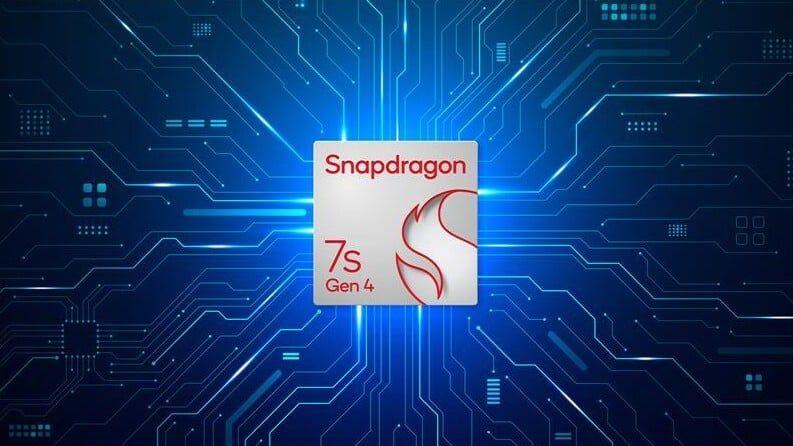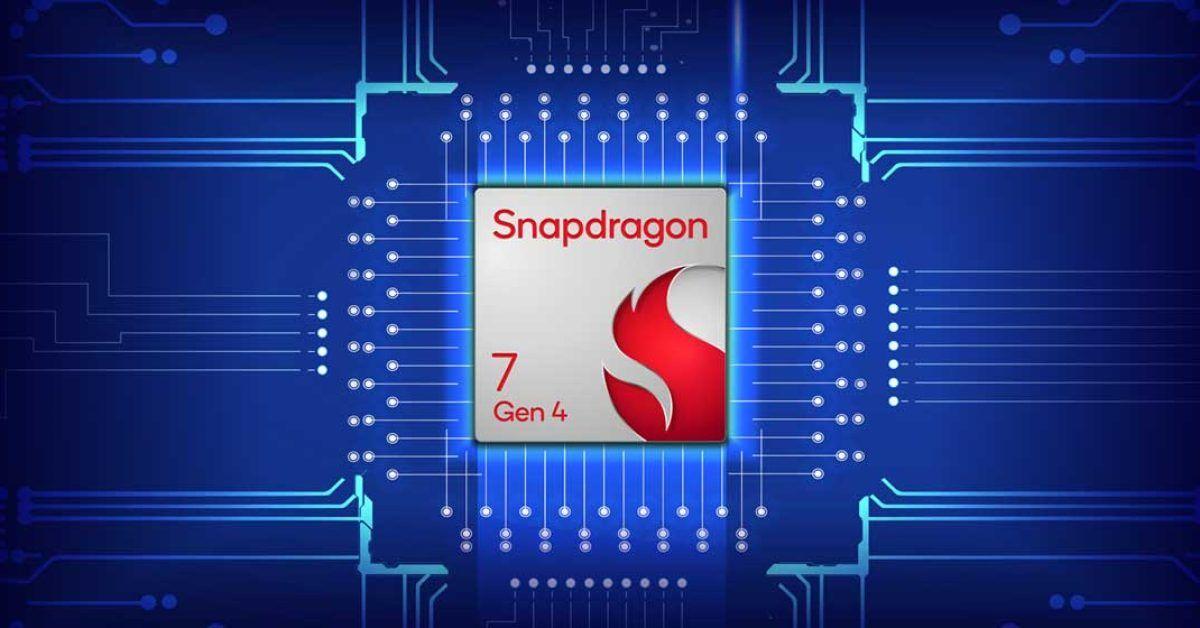Qualcomm Unveils Snapdragon 7s Gen 4: Modest Upgrades for Mid-Range Android Phones
4 Sources
4 Sources
[1]
This New Snapdragon Chip Makes Mid-Range Android Phones Better Than Ever
Smartphone chip maker Qualcomm spent most of 2024 bringing AI-enhanced features to its mid and low range platforms helping cheaper phones keep pace with flagships. Now, we're onto the next-generation of chipsets, and the new Snapdragon 7s Gen 4 features even more AI improvements, alongside a few smaller features. 2024's Snapdragon 7s Gen 3 chip powered the Nothing Phone 3a and 3a Pro, the Fairphone 6, and the rugged Samsung Galaxy XCover 7 Pro. It also featured on multiple handsets from Realme, Vivo, and Xiaomi, but none of these mid-range phones were available in the US. We don't yet know which phones will feature the new Snapdragon 7s Gen 4 chip, but we do expect to hear about the first wave of handsets through the rest of this year. It may mean we see it feature on more products from Samsung, and this series has also previously been used by Motorola for some mid-range devices. It's unlikely there will be a new Nothing phone with the chip before the end of the year. The brand has confirmed it has now finished its Nothing Phone 3 series, and it's unclear when it will move onto a sequel. What does the Snapdragon 7s Gen 4 give manufacturers making phones? As with every new Snapdragon chip, there are performance improvements, including a 7% jump in GPU performance compared to the last-gen. There's the same jump of 7% for the CPU, taking it up to 2.7GHz of power. That's up from 2.5GHz on last year's platform. Qualcomm's own Snapdragon 7 Gen 4 processor is slightly more powerful at 2.8GHz, but it also costs more. However, this is the closest the Snapdragon 7 and Snapdragon 7s series have been in terms of performance for at least a couple of years. This new platform is also designed to empower smartphone manufacturers to make mid-range phones with ultra-wide displays. The brand has brought 144Hz refresh rate and HDR10+ tech support to phones with a WFHD+ resolution allowing for an alternative aspect ratio of 12:5. It's unclear if we'll see any manufacturers make use of the feature. On the camera side, Qualcomm is allowing brands to make better use of its AI features by bringing features like Video Super Resolution to improve low quality footage and there's the return of the brand's AI Remosaic feature which removes grainy discoloration in shots. It wouldn't be a 2025 processor launch without talk of AI, which here includes support for LLM and LVMs including Llama 1B, Qwen 1B, and more. Qualcomm hasn't shared much specifically about this integration. It says "From on-device content creation to streamlining your productivity, the Qualcomm AI Engine puts fast, private, and responsive generative AI at your fingertips." The next step will be to see which manufacturers begin to use the Snapdragon 7s Gen 4, and whether all of these features are implemented on 2025 and 2026's best mid-range handsets. Like what you're reading? Don't miss out on our latest stories. Add PCMag as a preferred source on Google.
[2]
Qualcomm's Snapdragon 7s Gen 4 boosts CPU and GPU, supports ultra-wide displays
Nearly a year to the day after unveiling its predecessor, Qualcomm is ready to debut its next AI-centric mid-range processor. While we'll have to keep on waiting for an eventual Snapdragon 8 Elite 2 unveiling, the Snapdragon 7s Gen 4 is here to sate your appetite for new chipsets for at least another month. The Snapdragon 7s Gen 4 isn't a massive leap over its predecessor, but it should keep OEMs -- and consumers' wallets -- happy for another year. That said, it's not a huge leap over the chipset it's replacing, maintaining a 4nm process and the same 1x3x4 architecture for its Kryo CPU. While Qualcomm will presumably make the jump to utilizing its custom Oryon CPUs, it's clearly not ready to bring that leap to mid-range chipsets just yet. The result is a relatively slim leap in performance, with the brand promising a 7% leap in speed over the previous generation. That's likely coming from the single 2.7GHz Cortex-A720 prime core, delivering a small boost in clock speed compared to the 2.5GHz Cortex-A720 core found in last year's chipset. Both its three Cortex-A720 performance cores and four Cortex-A520 efficiency cores are completely unchanged from last year, with each maintaining their 2.4GHz or 1.8GHz clock speed, respectively. Qualcomm's upgraded Adreno GPU isn't a massive leap forward year-over-year either, delivering a similar 7% increase in performance compared to the 7s Gen 3. Really, the big change for graphics has nothing to do with horsepower, but the types of screens it supports, as the Snapdragon 7s Gen 4 now includes ultra-wide displays up to 2900×1300 running at 144Hz. That might not impact most smartphones, but it could be useful for emulation devices down the line. While older Snapdragon 7 chipsets were primarily locked to devices sold in China and Europe, the Snapdragon 7s Gen 3 made a bit more of a splash in North America, thanks in part to its inclusion in the Nothing Phone (3a) series (though, that phone similarly saw a fairly limited "beta" launch here in the US). As 9to5's Ben Schoon found in his review, Qualcomm's 2024 entry wasn't quite up to snuff with what you'd expect from the brand's flagship entries, but simultaneously, the overall package was "far from slow." Largely speaking, this is a pretty small bump for one of Qualcomm's more budget-friendly chipsets; even Gen AI capabilities -- usually a talking point for the brand -- don't seem particularly changed compared to last year's release. If you're looking forward to something more exciting, the follow-up to last year's Snapdragon 8 Elite 2 shouldn't be too far off.
[3]
Qualcomm Snapdragon 7s Gen 4 Announced with Modest Gains - Phandroid
Qualcomm has introduced the Snapdragon 7s Gen 4, the newest entry in its Snapdragon 7 family. This chipset is built for mid-range smartphones, and it promises performance gains, updated graphics, and better support for displays, cameras, and AI features. While it is not a huge leap forward, it shows Qualcomm's focus on refining the Snapdragon 7 lineup that powers some of the most popular Android devices. The Snapdragon 7s Gen 4 keeps the same 1+3+4 CPU core setup as the previous 7s Gen 3, but its Prime Cortex-A720 core now runs slightly faster at 2.7GHz. Qualcomm says this delivers around a 7 percent bump in CPU performance. The updated Adreno GPU is also about 7 percent faster and supports features like Snapdragon Elite Gaming, Adaptive Performance Engine 3.0, and Game Super Resolution. The chip also adds support for ultra-wide displays up to 1,300 × 2,900 pixels with refresh rates of up to 144Hz. The updated Spectra ISP can handle cameras up to 200MP and 4K video recording at 30fps with HDR10 and HDR10+ formats. AI also gets a boost thanks to an upgraded Hexagon NPU, which supports models like Llama 1B and enables real-time translation. In terms of connectivity, the 7s Gen 4 supports sub-6GHz 5G, Wi-Fi 6E, Bluetooth 5.4, and Qualcomm's Quick Charge 4+ technology. Compared to the Snapdragon 7s Gen 3, the new 7s Gen 4 offers only minor CPU and GPU gains but brings meaningful improvements for displays, imaging, and AI tasks. It is more of an incremental update than a complete overhaul. As for the Snapdragon 7 Gen 4, that chip actually has a Prime core with a slightly faster clock speed at 2.63GHz, giving it stronger peak CPU performance in some cases. However, the Snapdragon 7s line focuses more on efficiency and newer AI features, so the differences often come down to what a smartphone maker prioritizes.
[4]
Qualcomm Snapdragon 7s Gen 4 SoC Launched
Qualcomm, a semiconductor major, has launched the Snapdragon 7s Gen 4 SoC in India. It is a direct successor to the Snapdragon 7s Gen 3. There's a virtually unchanged Kyro CPU with an unchanged core architecture of 1 + 3 + 4. However, there's now an overclocked Prime Cortex-A720 core at 2.7 GHz. The 7s Gen 3 featured a 2.5 GHz clocked Prime Cortex A-720 crore. Compared to the predecessor, this chip can deliver a performance gain of 7%. The 7% gain is not just in CPU performance, but also in the GPU performance. Read More - Vivo V60 5G Now Available in India The phone features a Qualcomm Adreno GPU, and comes with support for Snapdragon Elite Gaming features like Adaptive Performance Engine 3.0 and Snapdragon Game Super Resolution. There's an updated Spectra ISP which will be able to accomodate 200MP sensors and shoot videos in 4K @30 fps, including Hybrid Log Gamma (HLG), HDR10+, and HDR10 formats. Then there's an updated Hexagon NPU to support better AI performance with support for Qwen 1B and Llama 1B and real-time translation. There's support for LPDDR5 RAM and 3.2 GHz and UFS 3.1 internal storage as well. The chipset will further support Qualcomm Quick Charge 4+ charging tech. On the connectivity side, the new 7s Gen 4 SoC supports sub-6 GHz 5G, Wi-Fi 6E and Bluetooth 5.4. There's also support for the aptX Lossless and apX Adaptive audio codecs.
Share
Share
Copy Link
Qualcomm has announced the Snapdragon 7s Gen 4, a new mid-range chipset for Android smartphones. The chip offers incremental improvements in CPU and GPU performance, along with enhanced AI capabilities and support for ultra-wide displays.
Qualcomm Introduces Snapdragon 7s Gen 4
Qualcomm has unveiled its latest mid-range chipset, the Snapdragon 7s Gen 4, aimed at enhancing the performance of mid-range Android smartphones. This new processor, succeeding the Snapdragon 7s Gen 3, brings modest improvements and new features to the table
1
2
.
Source: PC Magazine
Performance Enhancements
The Snapdragon 7s Gen 4 maintains the 4nm process and 1x3x4 architecture of its predecessor but offers incremental performance gains:
- 7% increase in CPU performance, with the prime Cortex-A720 core now clocked at 2.7GHz, up from 2.5GHz
2
3
- 7% boost in GPU performance with an upgraded Adreno GPU
1
3
- Support for Snapdragon Elite Gaming features, including Adaptive Performance Engine 3.0 and Game Super Resolution
4
Display and Camera Improvements
One of the notable upgrades in the Snapdragon 7s Gen 4 is its support for advanced display technologies:
- Capability to power ultra-wide displays with resolutions up to 2900x1300 pixels
2
- Support for 144Hz refresh rates and HDR10+ technology
1
The chipset also brings enhancements to camera capabilities:
- Updated Spectra ISP supporting cameras up to 200MP
3
4
- 4K video recording at 30fps with HDR10 and HDR10+ formats
4

Source: Phandroid
Related Stories
AI and Connectivity Features
Qualcomm has emphasized AI capabilities in this new chipset:
- Upgraded Hexagon NPU for improved AI performance
2
4
- Support for Large Language Models (LLMs) including Llama 1B and Qwen 1B
1
4
- AI-powered features like Video Super Resolution and AI Remosaic for improved image quality
1
In terms of connectivity, the Snapdragon 7s Gen 4 offers:
- Support for sub-6GHz 5G networks
3
4
- Wi-Fi 6E and Bluetooth 5.4 compatibility
3
4
- Quick Charge 4+ technology for faster charging
4
Market Positioning and Future Outlook
While the Snapdragon 7s Gen 4 represents a modest upgrade, it reflects Qualcomm's strategy to refine its mid-range offerings. The chipset is expected to power a range of devices from various manufacturers, potentially including Samsung, Motorola, and others
1
.The introduction of this chipset comes at a time when Qualcomm is focusing on bringing AI-enhanced features to its mid and low-range platforms, helping cheaper phones keep pace with flagship models
1
. However, it's worth noting that this release is more of an incremental update rather than a major overhaul of the Snapdragon 7 series3
.As the mobile industry eagerly anticipates the next generation of flagship processors, the Snapdragon 7s Gen 4 serves as a stepping stone, bridging the gap between budget-friendly and high-end smartphone experiences
2
. The real test will be in how smartphone manufacturers implement these features in their upcoming mid-range devices throughout 2025 and 20261
.References
Summarized by
Navi
[4]
Related Stories
Recent Highlights
1
Google launches Gemini 3 Flash as default AI model, delivering speed with Pro-grade reasoning
Technology

2
OpenAI launches GPT Image 1.5 as AI image generator war with Google intensifies
Technology

3
OpenAI launches ChatGPT app store, opening doors for third-party developers to build AI-powered apps
Technology








